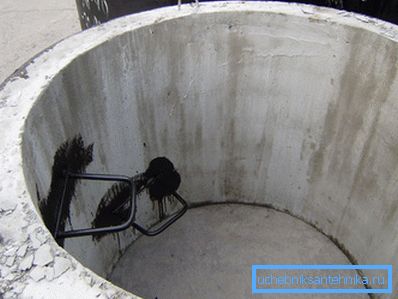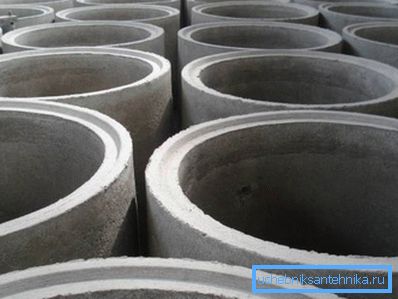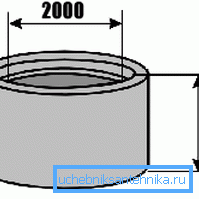Well rings: regulatory documents, popular questions and
What requirements does GOST 8020-90 contain for well rings? What types and sizes are these products? How much do they cost?
We will answer these and many other questions in the article.

Standard requirements
GOST 8020-90 regulates the production of all structures from heavy (that is, not porous in any way) concrete with and without reinforcement used for the construction of round wells for the following purposes:
- Sewer (inspection, cleaning, collector, etc.)
- Gas pipelines (of course, where the gas pipeline passes underground).
- Plumbing. These are wells for the evacuation of cold-water to a private house, designed to install valves on the highway, wells for fire hydrants and many others.
- Well storm sewer.
Curiously: the standard does not provide for the use of structures for the inputs of centralized heating, the construction of water intake wells, septic tanks and cesspools. However, in practice, such universal products are, of course, used much more widely than the normative document provides.
Let's go over the most interesting points of the standard.
- The marking of the product indicates its purpose and main dimensions. So, KS-25-12 is a wall ring (intended for a working chamber or a well mouth) with a diameter of 2.5 meters and a height of 1.19 meters (marking rounds the real values to the nearest round number).
- Reinforcement, if present, must be completely concealed by concrete to avoid accelerated corrosion. At the same time, the types of valves are strictly regulated.
- If the ring design provides for the running brackets, their width is assumed to be 30 cm, depth - not less than 12 cm. The brackets are protected from corrosion with a paint-and-lacquer coating.

- Rings can be stored in no more than two rows vertically. Bottoms and floor slabs - no more than six rows, with mandatory laying of gaskets, the thickness exceeding the height of the mounting hinges.
Questions and answers
As always, formal requirements create a somewhat incomplete impression of products that they standardize.. Let's put together typical questions that ask potential buyers of the products we are discussing. (See also the article Polymer rings for a well: design features.)
Dimensions
What could be the diameter of the rings? The diameter of the well ring varies from 60 to 250 centimeters.

To clarify: we are talking about the internal diameter. Outdoor by 16-24 centimeters more due to the thickness of the walls.
The minimum height of the well ring is only 150 millimeters (for example, for KS-7-1,5). Maximum - 3,5 meters (КС-7-3). However, products with a height of 90-100 centimeters are in the greatest demand.
What is the volume of water in the well ring? The volume of the cylinder is equal to the product of the square of its radius and height and pi. Thus, for the most running rings with an inner diameter of 1.5 meters and a height of 0.9 meters, the internal volume will be (0.75 ^ 2) x 0.9 x 3.1415 = 1.6 cubic meters.
To get the volume of the well ring in liters, it is enough to multiply this value by 1000: 1.6 x 1000 = 1600 l.

Kinds
Do these products always represent the usual thick-walled cylinder? Not at all.
In the price lists of manufacturers you can find the following types of them:
- Ring for a well with a lock (with a quarter) - a product with a groove and a protrusion on the upper and lower end, respectively. The design allows to avoid lateral displacement of the elements of the well and significantly simplify its sealing.

- Products with a bottom are designed for the installation of wells with a high level of groundwater, when drainage through the floor can lead not to the drainage of the well, but to its filling.
Note! Bottom rings are often used to build cesspools and primary sedimentation tanks in improvised septic tanks. However, for these purposes it is much better to use plastic containers or, in extreme cases, monolithic concrete structures. The instruction is associated with the inevitable, over time, leakage of seams and, as a result, soil contamination with untreated drains.
- The so-called dobornye are all products with a height of less than 40 centimeters. They are used with a non-standard height or depth of the created structure (not a multiple height of one large ring).
- Perforated - having a large number of holes in the walls. Their purpose is effective drainage of treated wastewater into the ground. The field of application is quite predictable: filtering wells of local sewage treatment plants are built from them.

Note: when choosing reinforced concrete products, it is worth considering that sellers (not manufacturers, namely sellers) do not always orient themselves in labeling or distort it. For example, the well ring K 10 by 10 may well be in the real world both the KC-10-10 ring and the KCD-10-10h, which differs from the previous one in the presence of a bottom, a lock and a two-fold difference in cost.
Price
How much does a well ring cost? Of course, the price depends on its size and shape.
Here are some examples from the price list found in the worldwide network.
- KS-7-6 (diameter 70, height 60, ordinary wall ring) - 850 rubles.
- KS-20-9 (200x90 cm) - 4500 rubles.
- KS-15-10ch (150x100 cm, with lock) - 3750 rubles.
- KCD-15-9 (150x90, with bottom) - 4650 rubles.
- KCD-20-10ch (200x100 cm, with the bottom and lock) - 18,000 rubles.

Conclusion
For more information on how to choose and how to mount well rings with your own hands, the reader, as usual, will find in the video in this article. Successes!